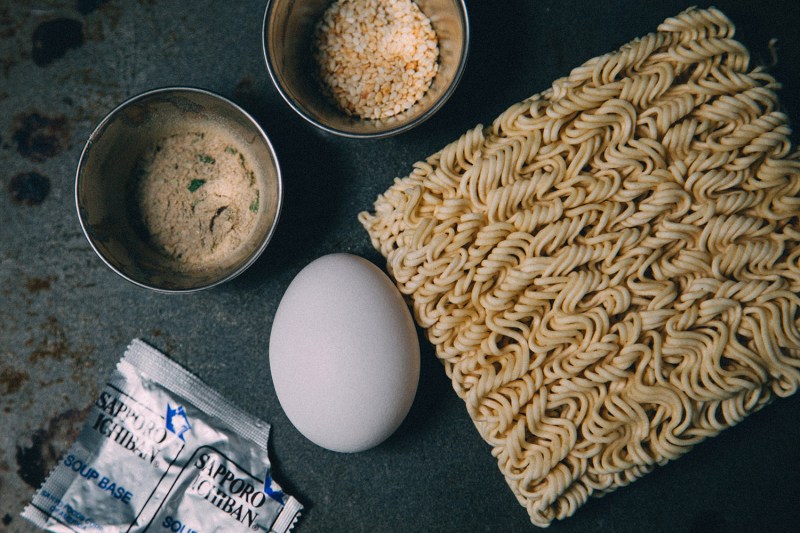Looking for a new dish to try out while you’re stuck inside the house? How about ramen? A cheap and easy meal known to countless college kids around the world, it is also being served at some of the finest restaurants as well. Thanks to its mutability, chefs have played with the soup to create wonders for the palate around the world. Whether you like pork or chicken, shoyu (soy sauce-based) or tonkatsu (pork bone-based) broth, or something completely different, chances are there is a ramen out there for you.
The thing about ramen, which is said to have originated in China and made its way to Japan in the mid-1800s (according to the Shinyokohama Ramen Museum), is that it is also pretty easy to make at home. Sure, you could spend years learning how to perfect it, but to get started, all you need is a little know-how and the right ingredients.
That’s where we come in. We asked chef Nick Sorrentino of New York City’s Katana Kitten, for his take on some easy-to-make at-home ramen.
Katana Kitten, which opened earlier in 2018, is a bi-level bar in the West Village that was created to offer not only Japanese-American food and drinks but a fun party environment.
Below, you’ll find Sorrentino’s thoughts on how to make ramen, as well as some tips and tricks for when you don’t have time.
How to Make Ramen
Chef Nick Sorrentino’s Favorite Recipe

“At home, I like a very straightforward broth with lots of ginger, onion, and soy flavor. Make sure to boil the noodles vigorously in unsalted water and beyond that, you’ll need a poached egg and lots of chili and scallion for garnish.”
Ingredients:
- 5 lb (750 g) fresh ramen noodles
- 3 lb pork shoulder (with bone if possible), cut into large pieces
- 1 lb double-smoked slab bacon
- 8 garlic cloves, chopped
- 1 large Spanish onion, coarsely chopped
- 1 leek, white and green parts halved lengthwise and coarsely chopped
- 1 egg to garnish (optional)
- 3 qt rich roasted chicken stock
- 6 oz dried shiitake mushrooms
- 4 oz ginger, peeled and chopped
- 2 tbsp canola oil
- Soy sauce and sesame oil for seasoning
- Kosher salt to taste
Method:
- Season and roast the pork shoulder, then place pork and slab bacon together in a large saucepot until golden brown.
- Remove the meat from the pan and place aside to drain.
- Add the onion, garlic, and ginger into the saucepot and sauté slightly.
- Return the reserved meat to the pot.
- Add the chicken stock, chopped leek, and dried mushrooms.
- Bring to a full boil and lower heat to a simmer.
- Adjust seasoning with soy sauce.
- Allow to simmer and reduce for 4 hours.
- Drain the broth and return the broth to the stove.
- Lightly shred the pork and return the pork to the broth.
- Boil ramen noodles according to the packaging.
- Top the noodles with the broth.
- Garnish with sliced scallions, poached egg, and sesame oil.
Tips for Making Instant Ramen Better

Not ready to say goodbye to your Top Ramen or Cup Noodles? That’s okay, too. We know it can be hard to say goodbye to yesterday, that’s why we also got some tips and trips for how to hack your regular old cup of ramen noodles. The first tip comes to us from Masahiro Urushido, also of Katana Kitten.
“I have one killer cup noodle recipe which you can see the image on my Instagram: Classic Nissin Cup Noodle with porcini broth instead of simple hot water topped with shaved truffle and few droplets of white truffle oil. It’s my delicious guilty pleasure. One morning, after the holidays last year, I found leftover Burgundy black truffle in the fridge,” he says.
“Under the pressure of having to use it before it went bad, and partly wanting to keep the special holiday mood going, I took a Nissin Cup Noodle (beef flavor) from the pantry and added pieces of dry porcini mushroom. I used a Japanese cast iron teapot to prepare the water, opened the lid at 2 minutes and 45 seconds in (for perfect al dente), and shaved off a generous amount of truffle with a little drizzle white truffle oil also. The beef flavor works well with truffle. It is essentially a consommé, and the porcini broth adds deeper flavor while rehydrating the dried mushrooms’ umami flavor.”
When he isn’t making his own ramen, Sorrentino employs the use of a few different spices to liven up his cup of noodles.
“My go to’s are furikake, which comes in a variety of flavors and for some spice. I always have togarashi powder or sambal paste,” he says. “Also a few drops of sesame oil and some sesame seeds add a great richness and some crunch.”
Either way, make sure you have a highball ready to drink, too.



